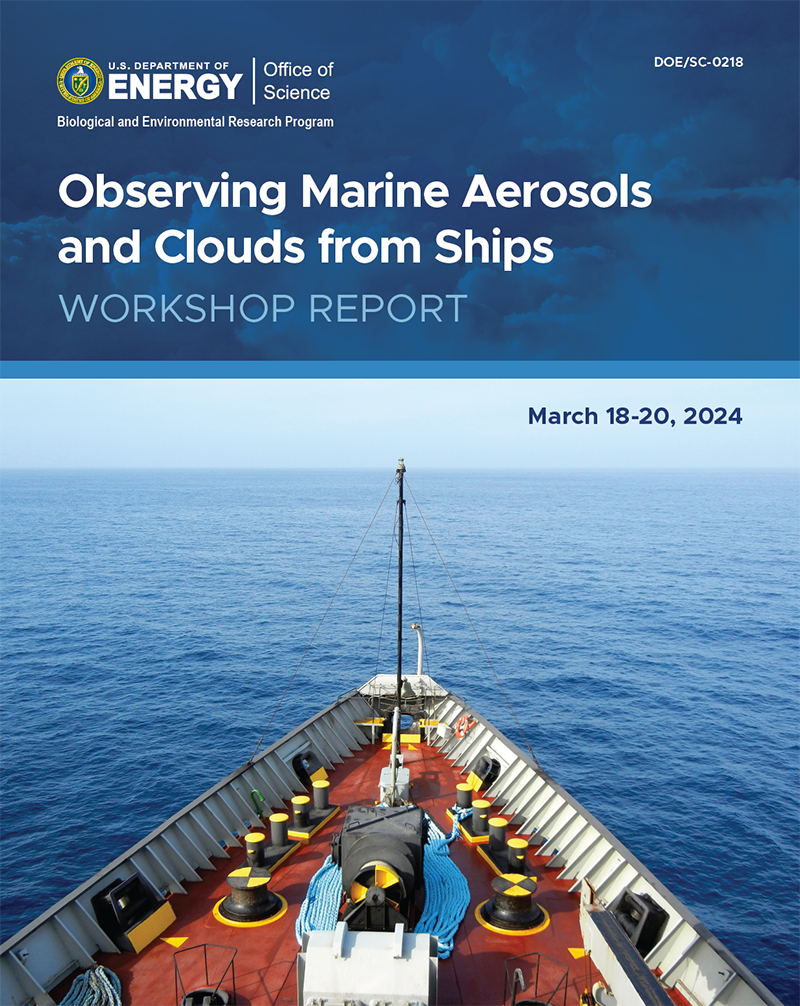DOE Workshop Explores Observing Marine Aerosols and Clouds From Commercial Ships
Published: 18 July 2024
Experts outline logistical challenges, instrumentation priorities, multi-agency coordination, and science questions

During a recent U.S. Department of Energy (DOE) workshop held virtually from March 18 to 20, 2024, experts discussed the feasibility and scientific priorities of observing marine aerosols and clouds from commercial ships. An ensuing workshop report was published in June.
Workshop participants brought a wide range of expertise in instrumentation, ship-based observations, and the use of marine observations in their research to the discussions. To obtain a broad perspective from the community, participants included scientists whose research is funded by DOE, NOAA, NASA, and the National Science Foundation. Scientists affiliated with DOE’s Atmospheric Radiation Measurement (ARM) user facility and Atmospheric System Research (ASR) program played important roles in the workshop, serving as breakout session facilitators and report authors.
At a 2018 workshop hosted by DOE’s Biological and Environmental Research (BER) program, which supports ARM and ASR, participants identified the highest-priority opportunities for ARM Mobile Facility capabilities to best address BER’s goal of improving the predictability of earth system models. Marine regions were identified as a key area for further study.
“Earth system models suffer from major biases in their representation of clouds, precipitation, and aerosols in marine regions,” says the report on the 2018 workshop. “There is a great need for surface and in situ observations of clouds, aerosols, and precipitation in marine regions, but logistical and measurement challenges mean that such observations are mostly restricted to relatively short campaigns with research vessels and/or aircraft.”
The 2024 workshop aimed to identify scientific priorities, logistical challenges, and opportunities for deploying shipborne instrumentation on commercial vessels. During the 2012–2013 Marine ARM GPCI Investigation of Clouds (MAGIC), ARM instruments collected data on a commercial ship that traveled between California and Hawaii.
“Overall,” says Nasiri, “the workshop provided valuable insights into the challenges and opportunities of observing marine aerosols and clouds from ships. Leveraging commercial ships as observational platforms could significantly expand the reach of shipborne observations and improve our understanding of Earth’s climate system.”
Report Takeaways
Key takeaways from the report include:
Logistical challenges: The workshop highlighted vital logistical challenges, including developing good relationships with shipping companies, instrument installation and maintenance in port, instrument location on the ship, data quality control, and legal issues.
Coordination with existing activities: Participants identified existing programs supported by other federal agencies that are conducting measurements of oceanic properties, surface meteorology, and greenhouse gases on commercial ships. Coordination with these programs would be valuable for a shipborne observations program.
High-priority instrumentation: Feasible measurements for unattended operation on ships include surface meteorology, aerosol size distribution, carbon monoxide mixing ratios, aerosol number concentration, aerosol optical properties, broadband radiation, ship position/navigation, cloud base height, and liquid water path.
Scientific questions: The workshop identified several scientific research topics that could be addressed with shipborne measurements, including environmental controls on cloud properties, aerosol-cloud interactions, marine boundary-layer structure, aerosol variability in different ocean regions, and the direct radiative impacts of aerosols.
Keep up with the Atmospheric Observer
Updates on ARM news, events, and opportunities delivered to your inbox
ARM User Profile
ARM welcomes users from all institutions and nations. A free ARM user account is needed to access ARM data.


















